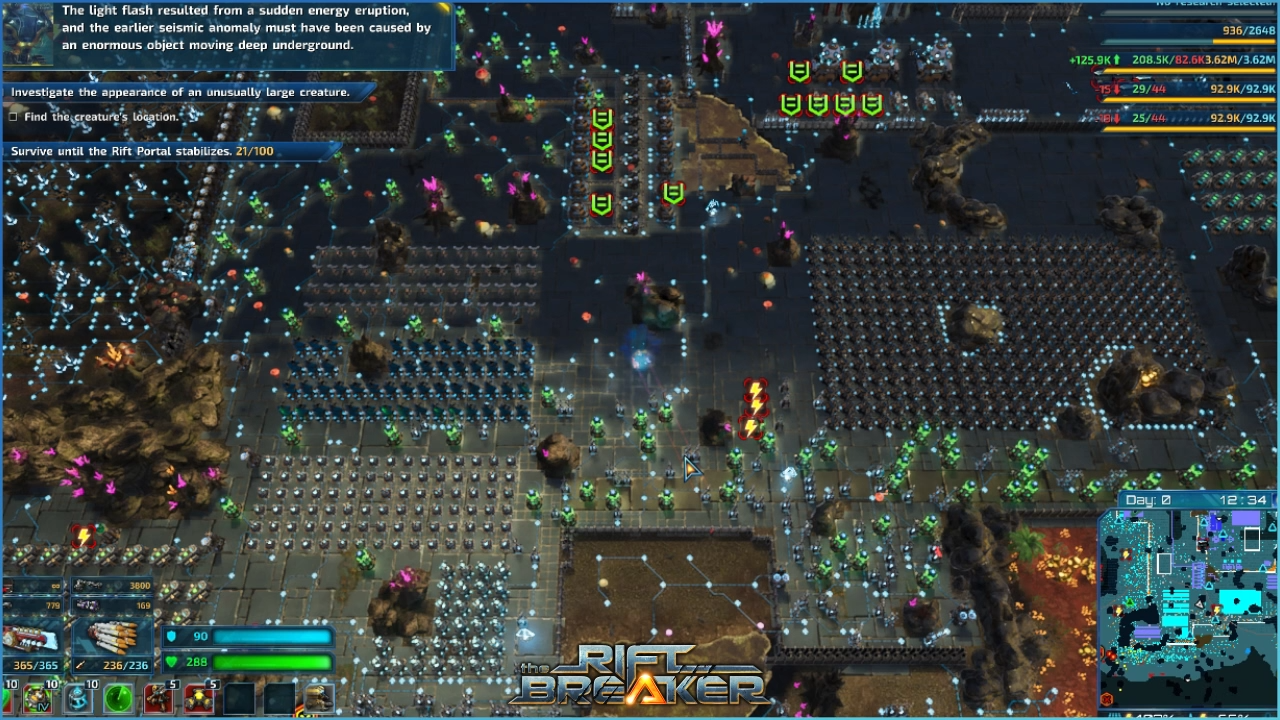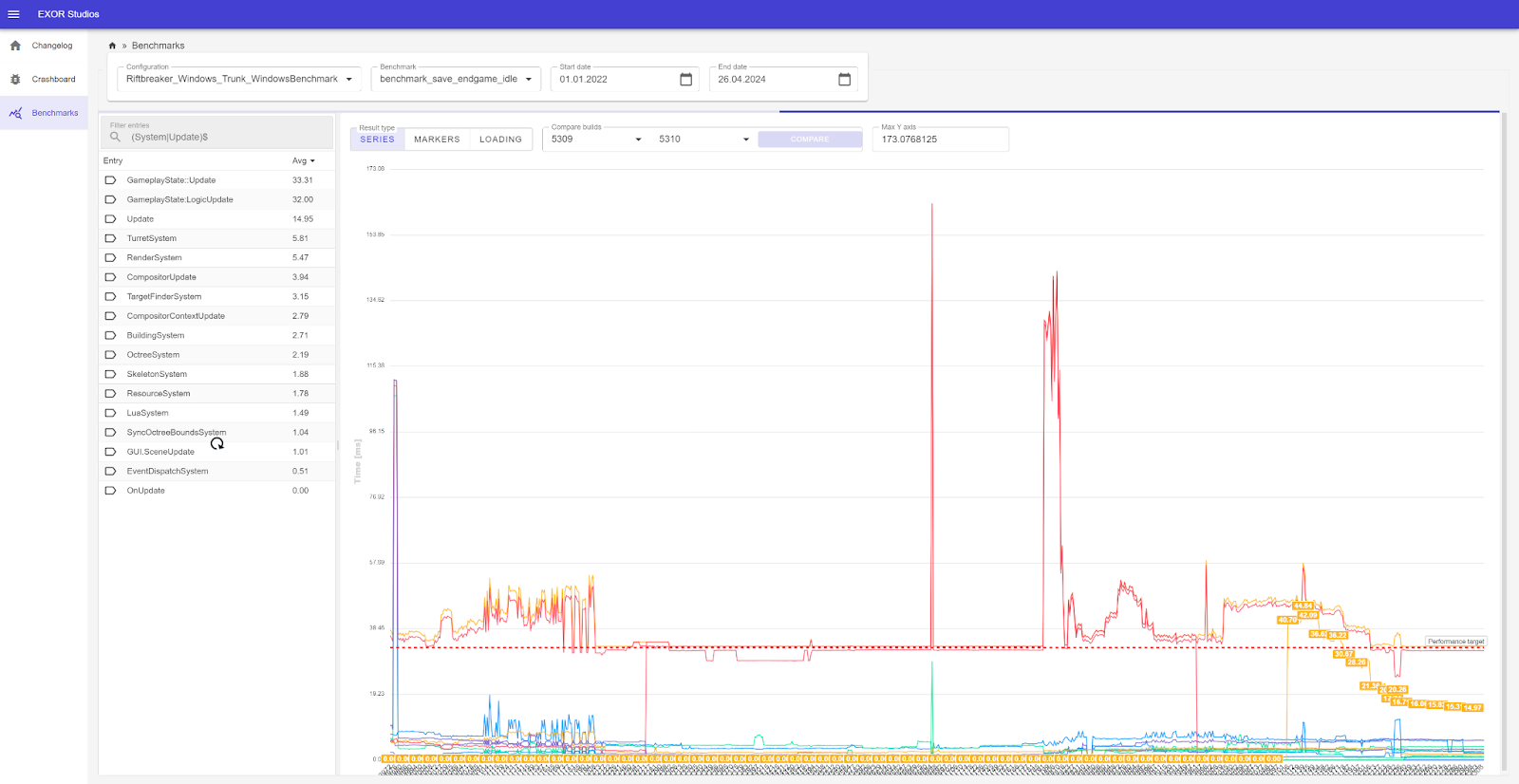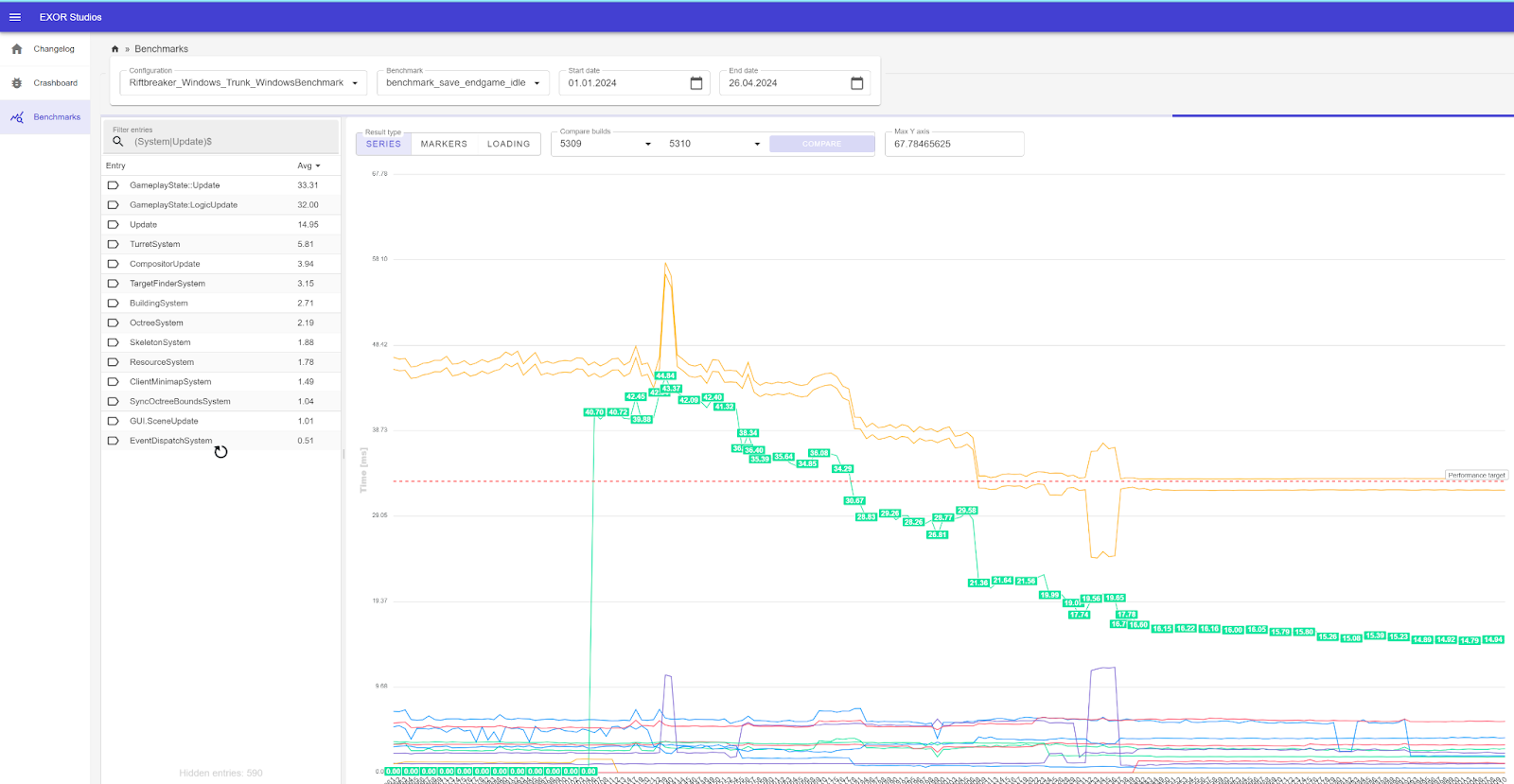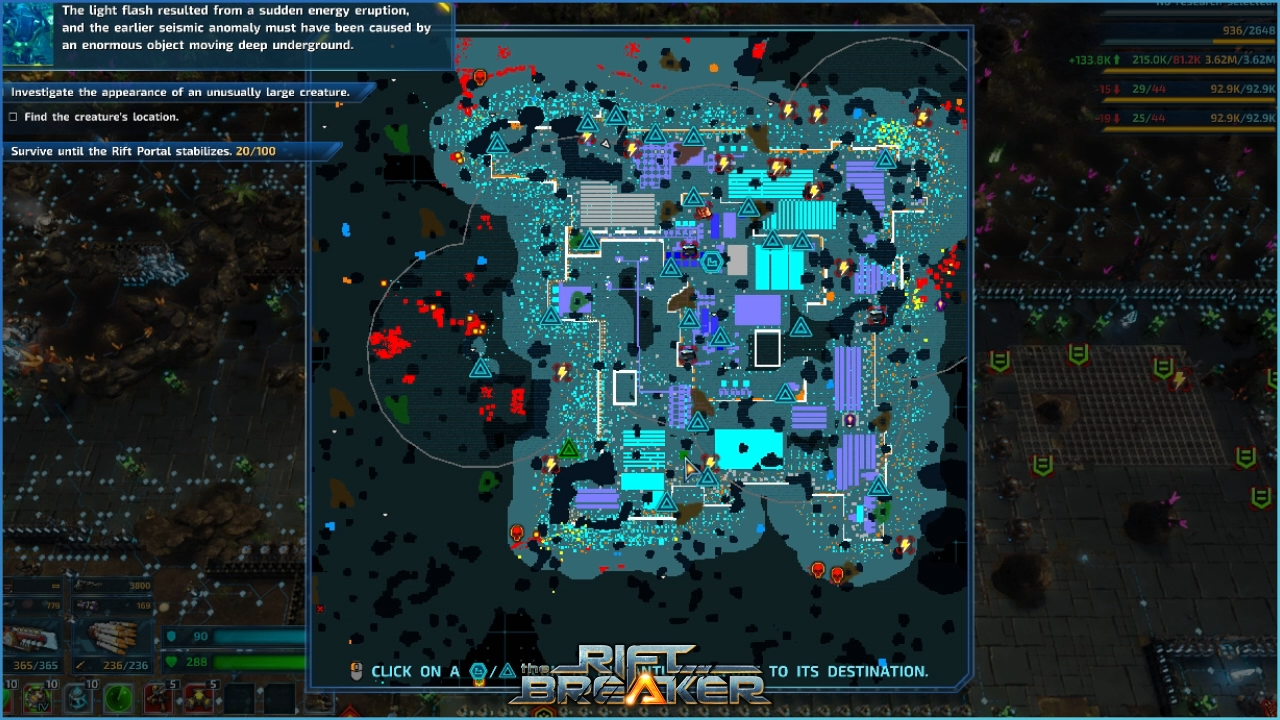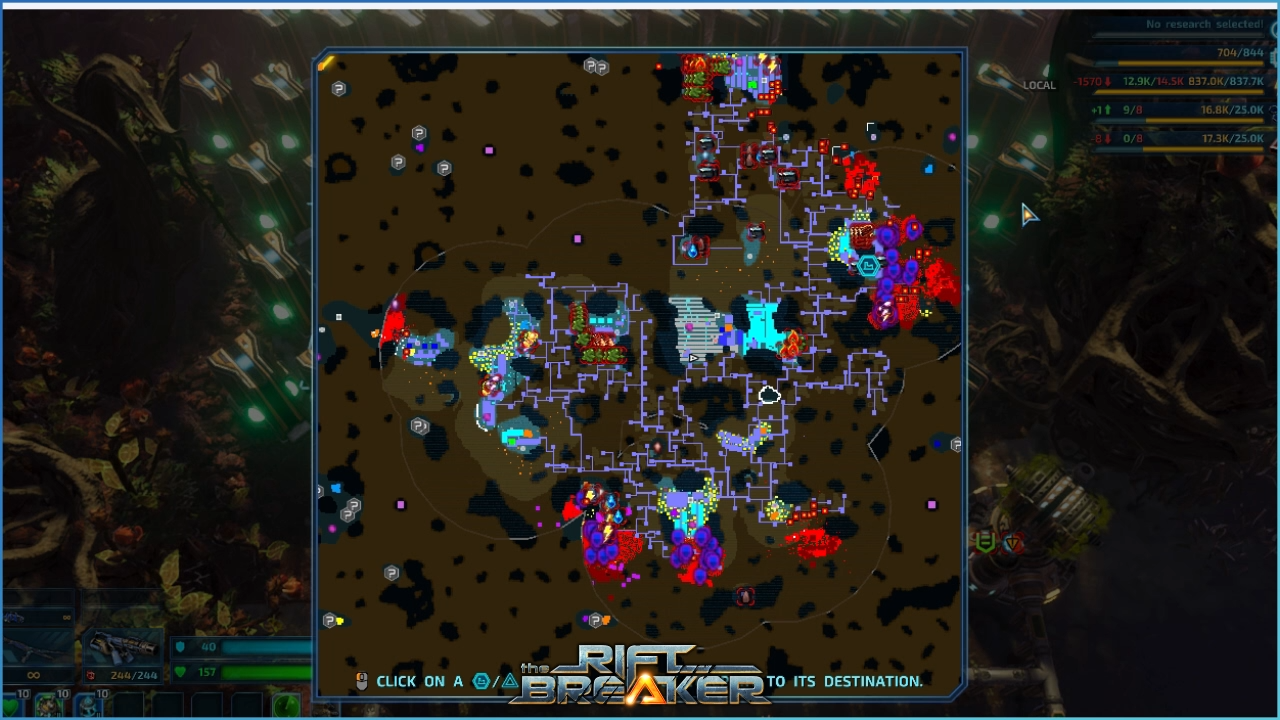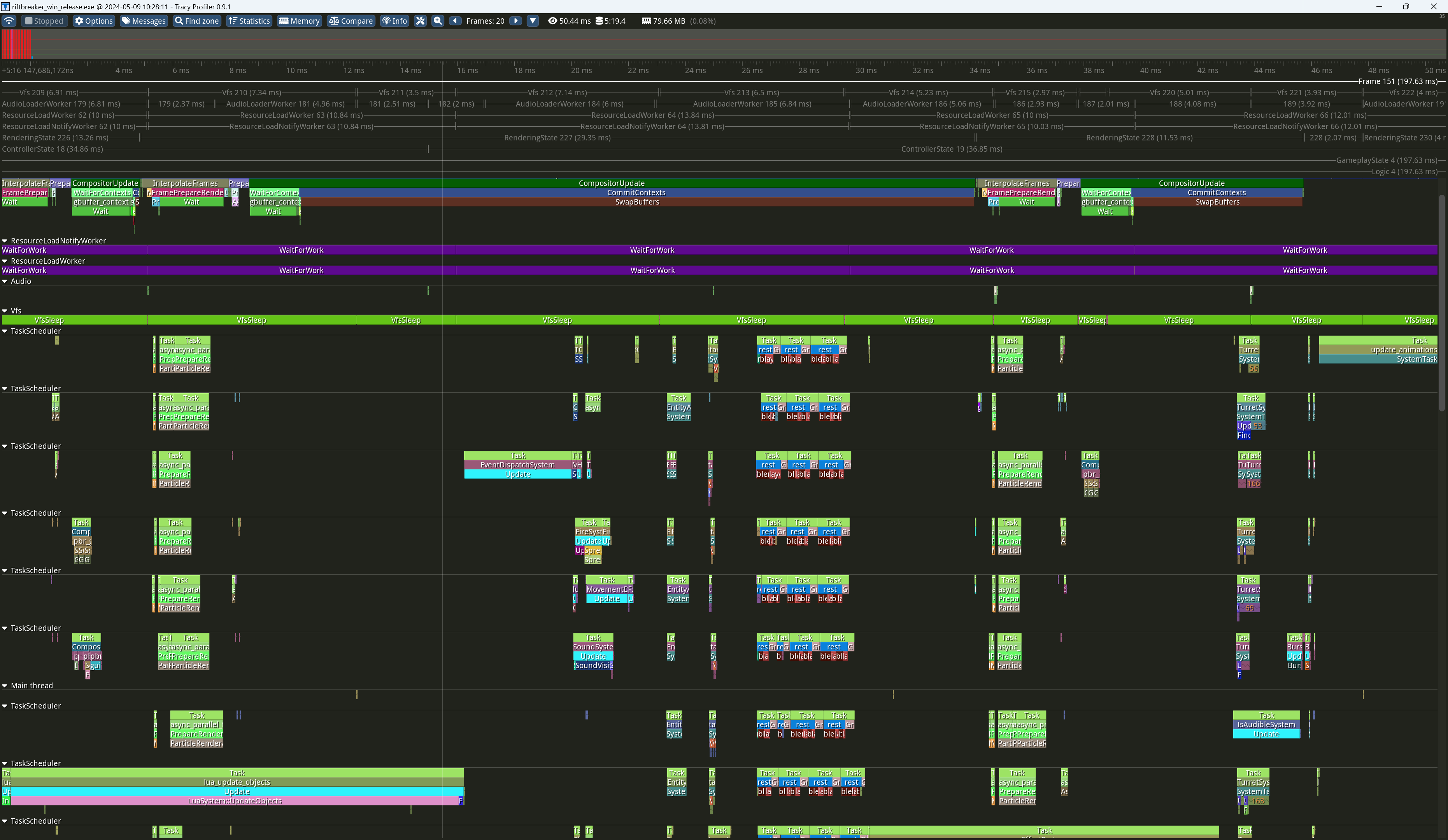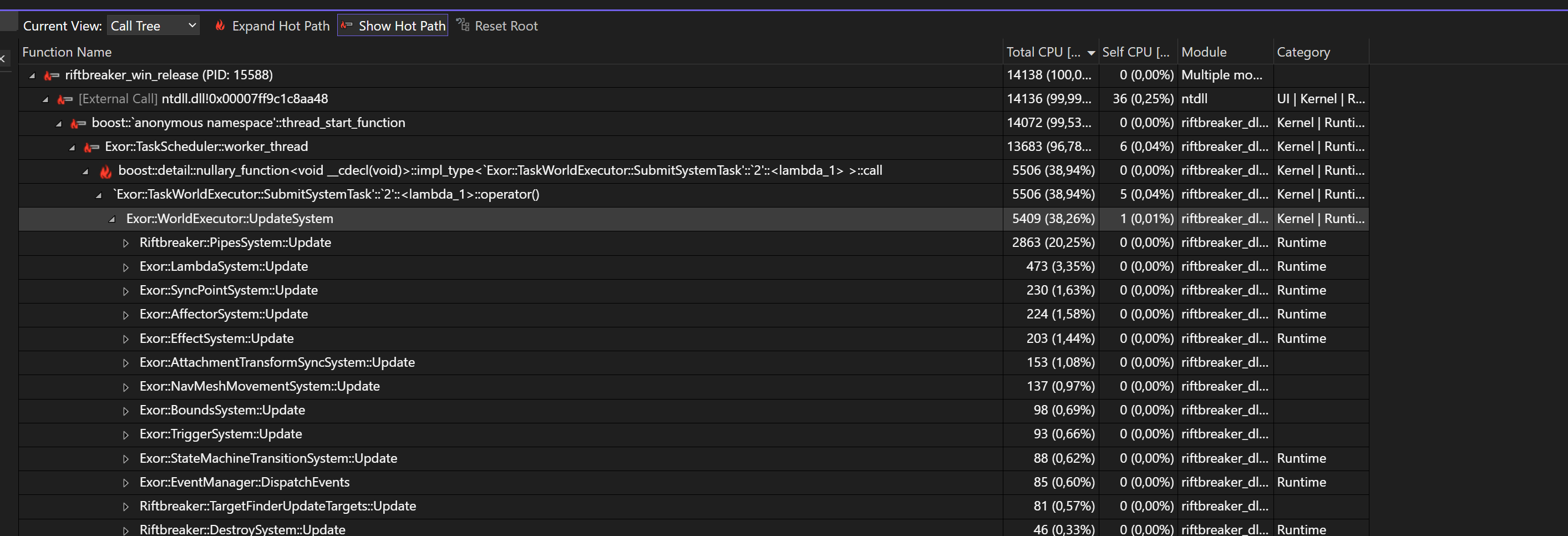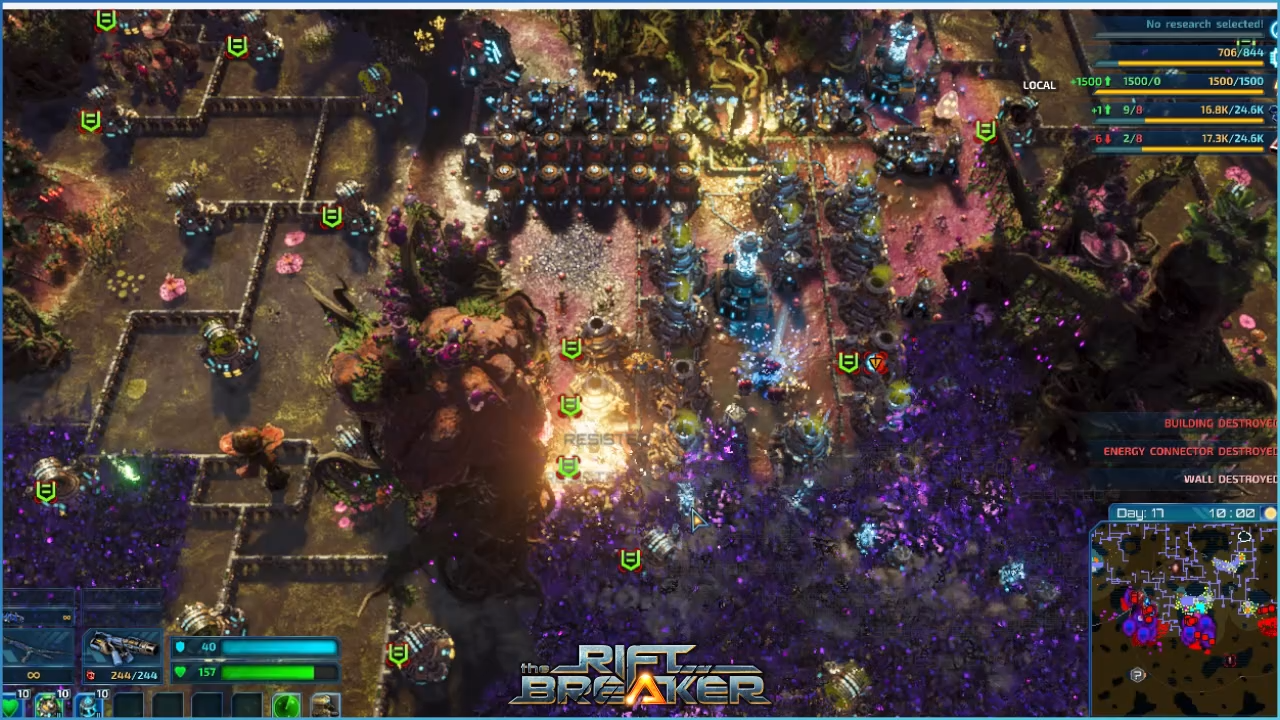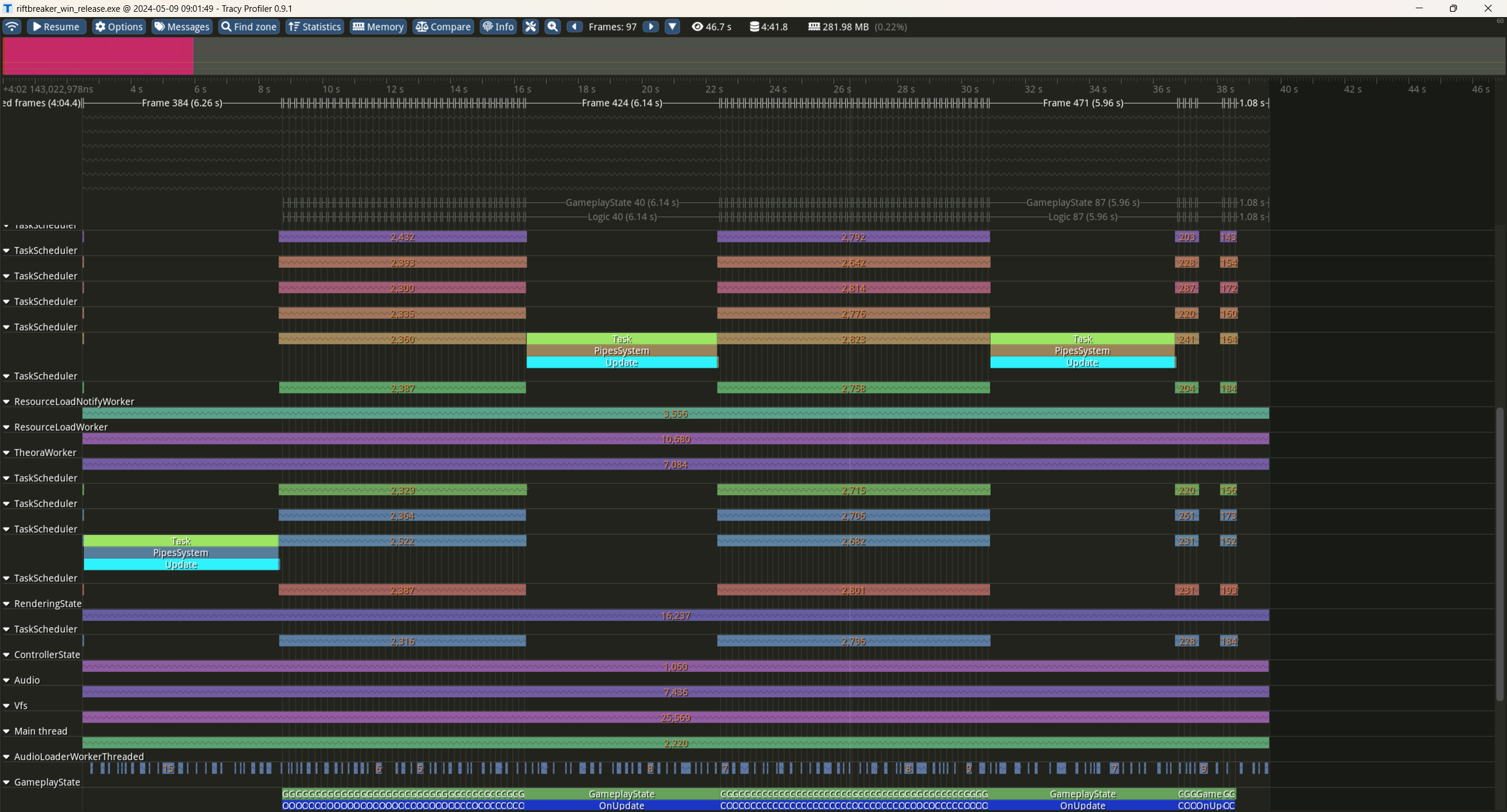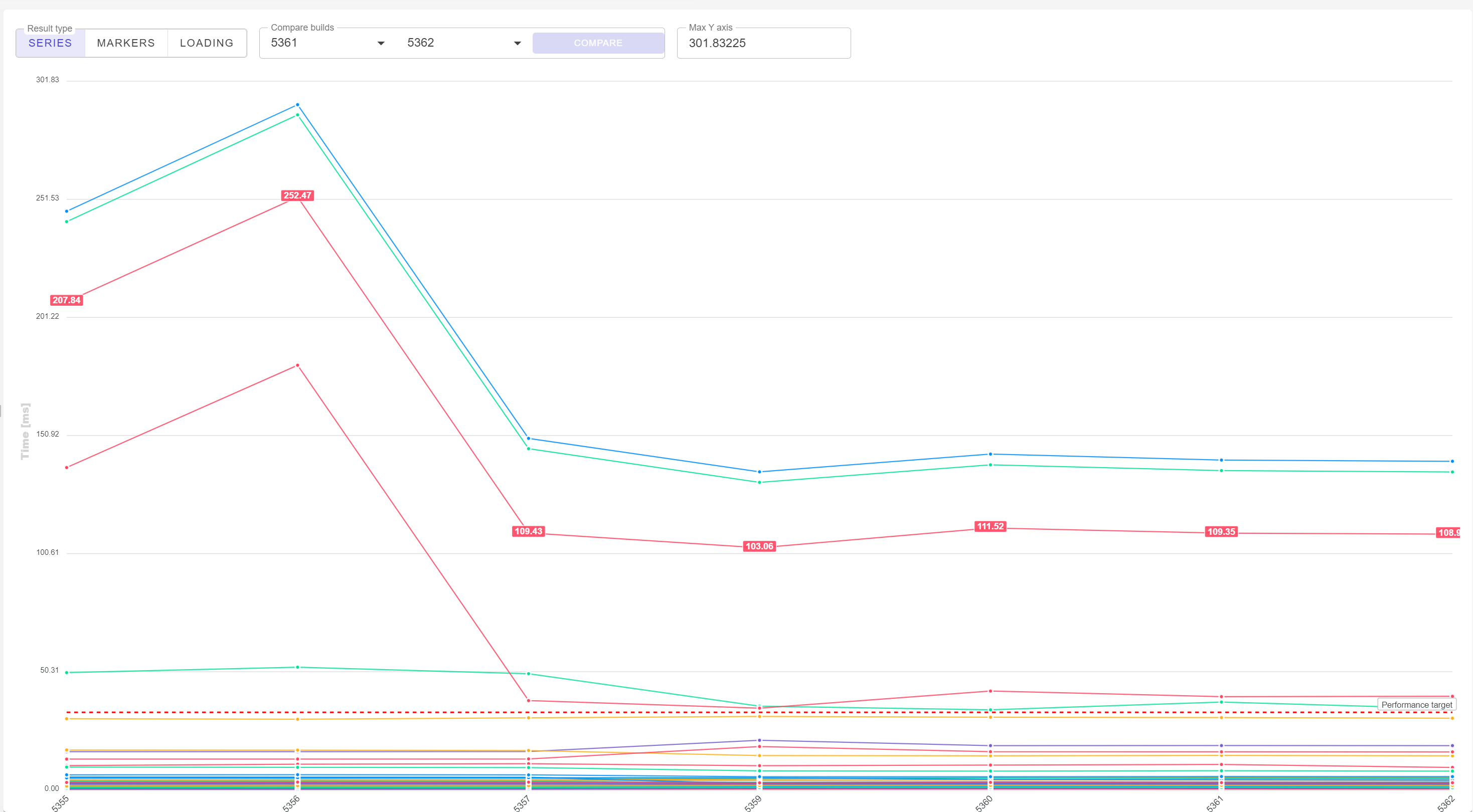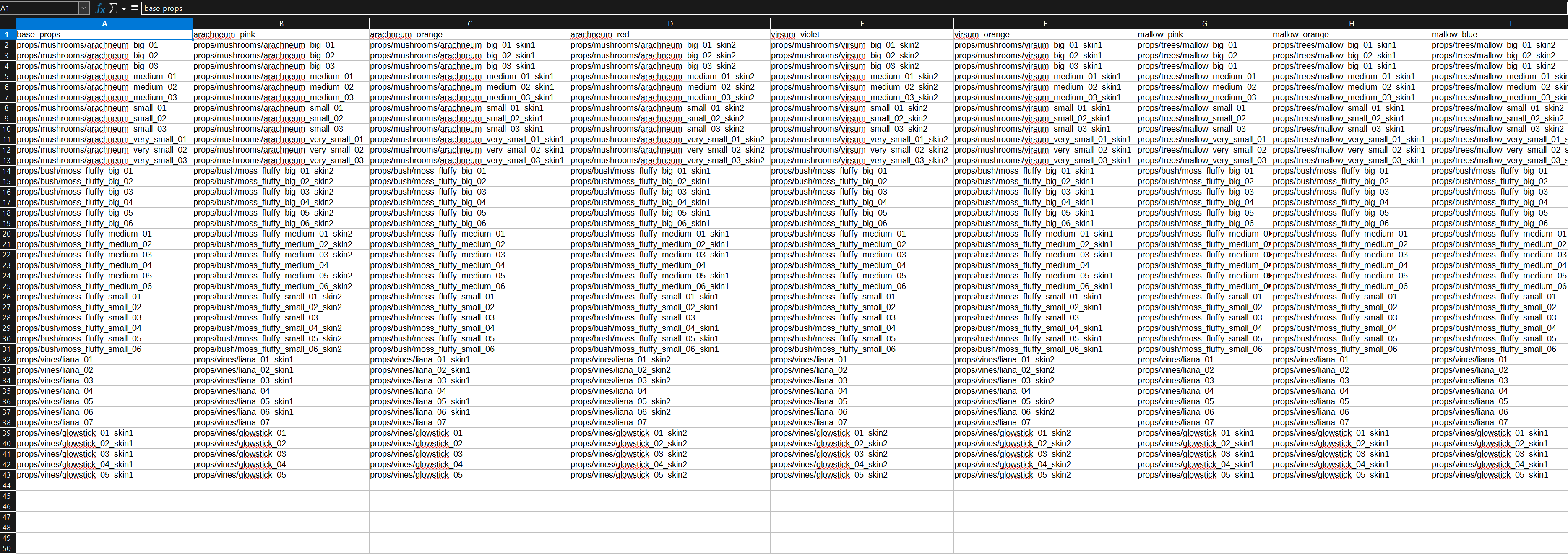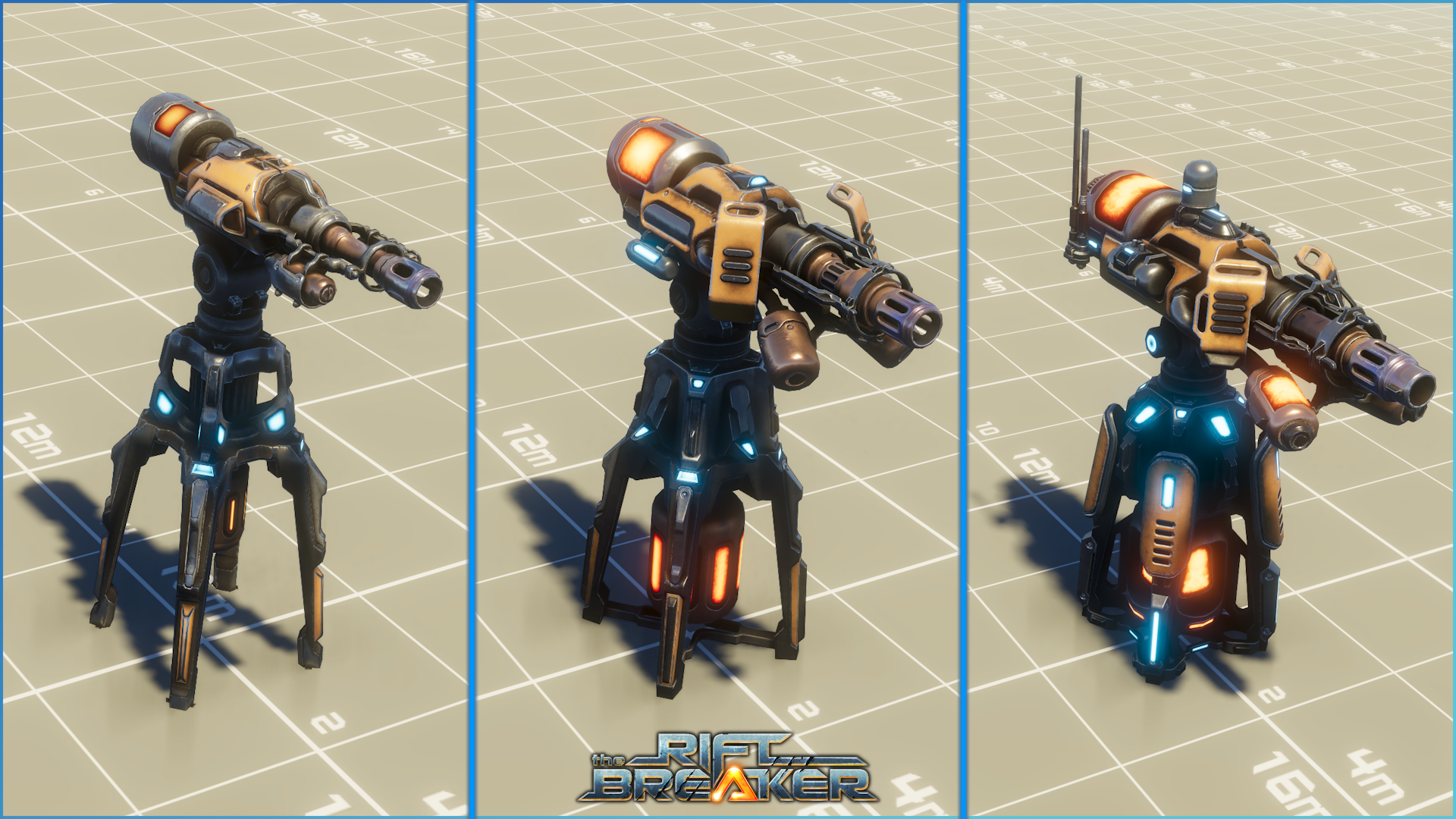
May 24, 2024
The Riftbreaker - voidreaver
Hello Riftbreakers!
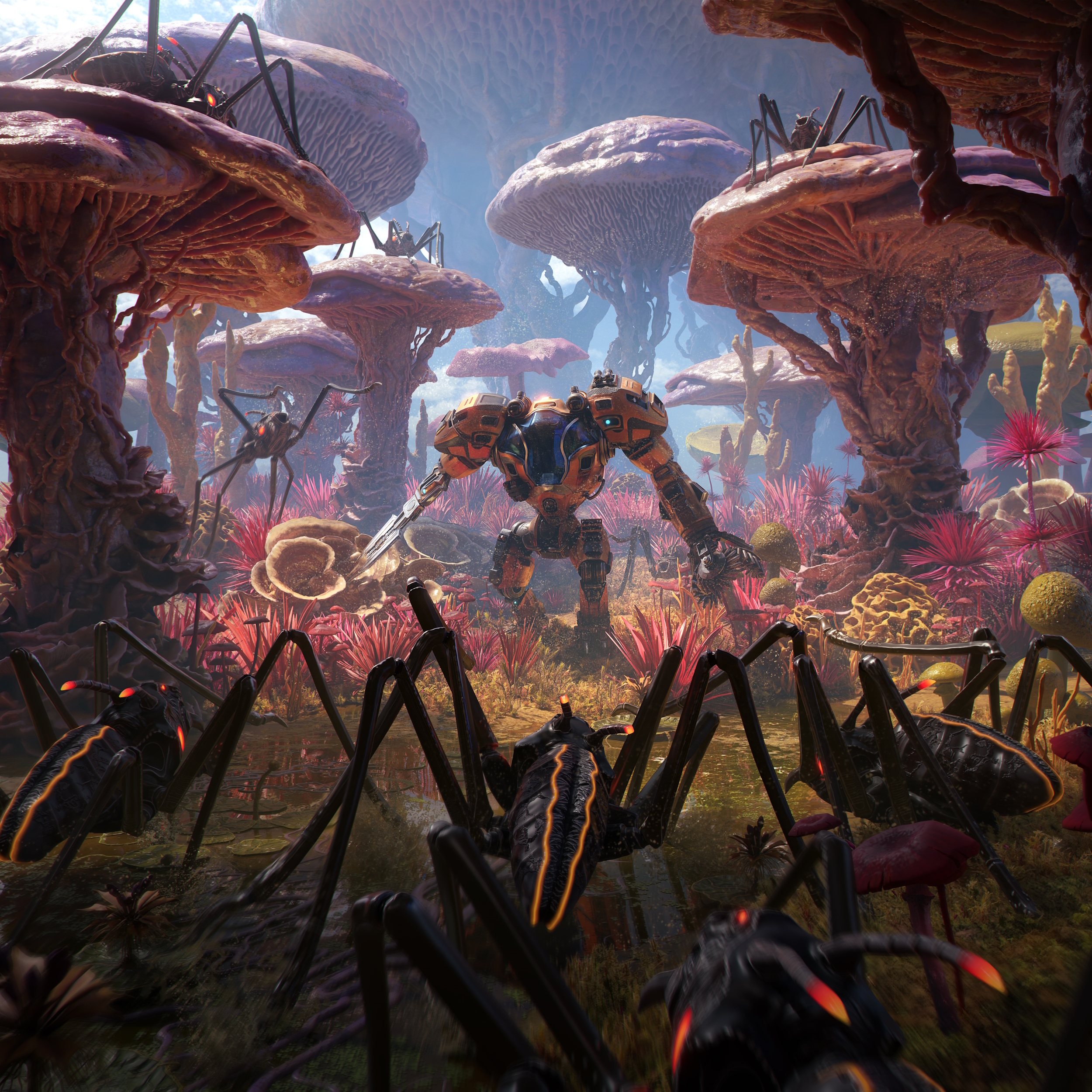
It is our pleasure to invite you all to participate in the open beta test of World Expansion III for The Riftbreaker. It is by far the biggest update we have made up to this point. In the words of one of our developers: “I’m not sure if there is a single class in the engine we haven’t touched since the last patch.” The update comes with thousands of improvements, hundreds of bug fixes, and dozens of new features. Your feedback, bug reports, and suggestions will be an invaluable help to make this update as good as possible. Let’s now talk about the contents of the open beta.
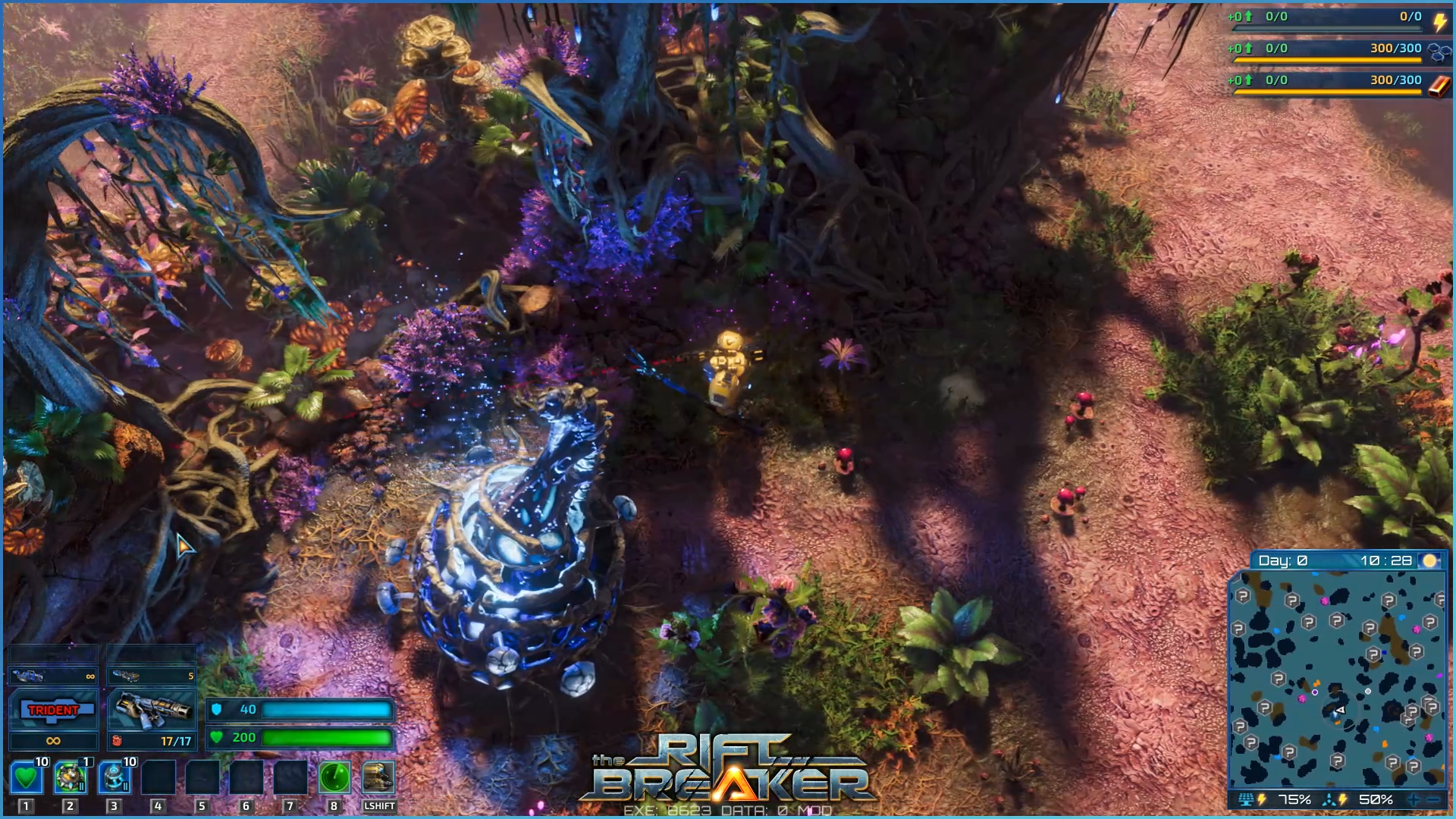
The Experimental Open Beta of World Expansion III allows you to explore the brand-new Fungal Swamp biome in Survival Mode. The Fungal Swamp is an area with huge variability in terrain formation - sometimes dry land is plentiful, and other times, you are surrounded by water on all sides. This is why there are two Survival Maps to choose from. The Fungal Forest map will take you to a more dry part of the biome, allowing you to test your skills in a more classic setting. On the other hand, the Fungal Swamp map is going to be an entirely new challenge. You will have to build your base on small islands and pay close attention to space management, energy production, and defenses. Luckily, there are plenty of new technologies to help you with that.
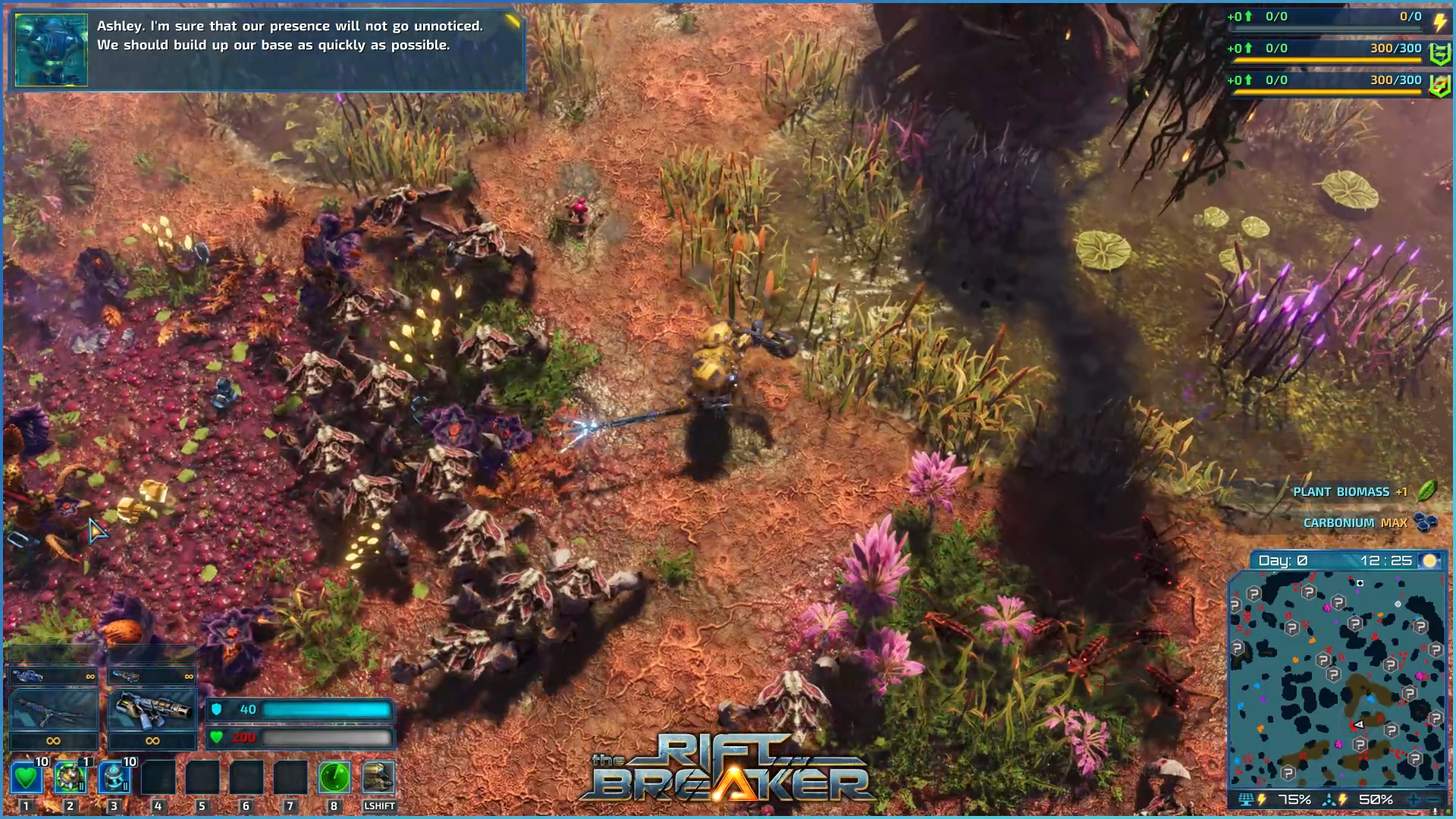
The Riftbreaker: World Expansion III comes with 65 new technologies for you to choose from. From advanced power generation setups, to completely alien weaponry, you will surely find something interesting to incorporate into your strategy. The research trees have been updated to accommodate all these items. We highly encourage you to try everything out - especially the new, giant defensive towers you suggested on our suggestion board over at https://riftbreaker.featureupvote.com!
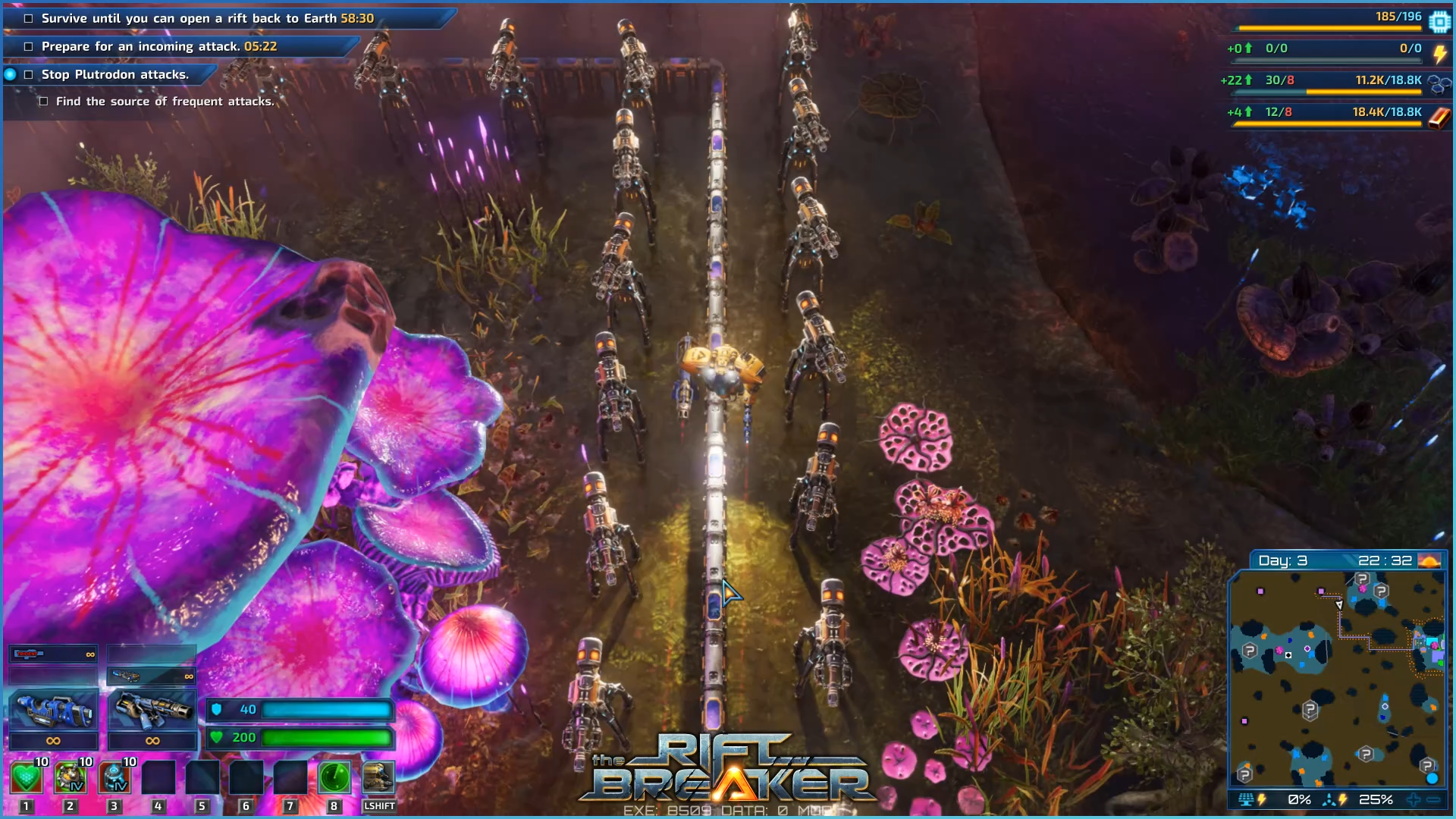
All of this content will come to all our players as a FREE UPDATE when we are ready to release the full version of the World Expansion III.
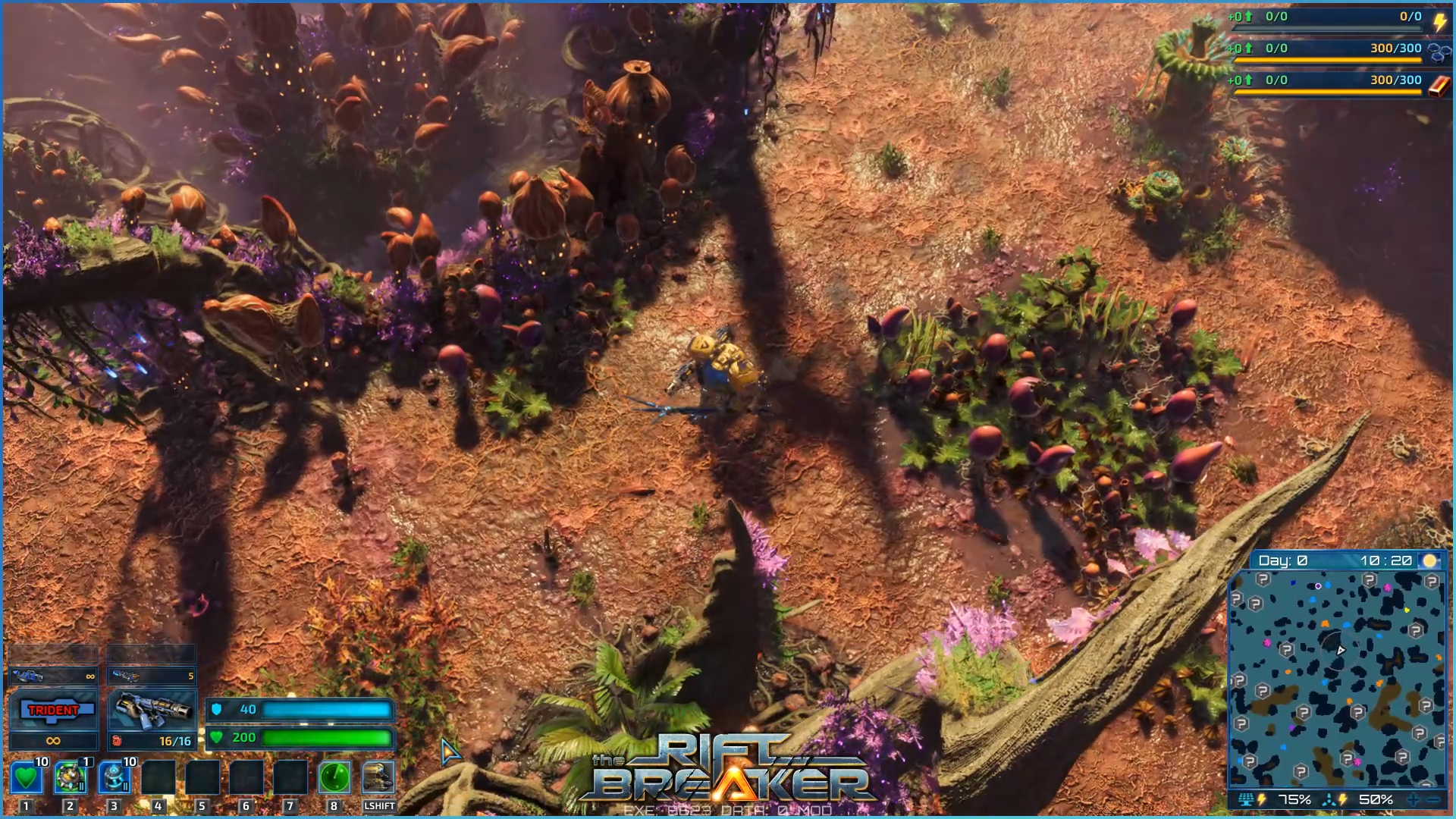
This Beta does not contain any new Story Campaign content. That will be a part of the paid Heart of the Swamp DLC, and we want to keep it a secret until its release.
https://store.steampowered.com/app/2506610/The_Riftbreaker_Heart_of_the_Swamp/
WISHLIST NOW
Please note that this is a beta test. Many things are still unfinished, unbalanced, or use placeholder assets. Errors are expected. The game might crash or break - please report all such instances to us either on the Steam Forum or our Discord at www.discord.gg/exorstudios.
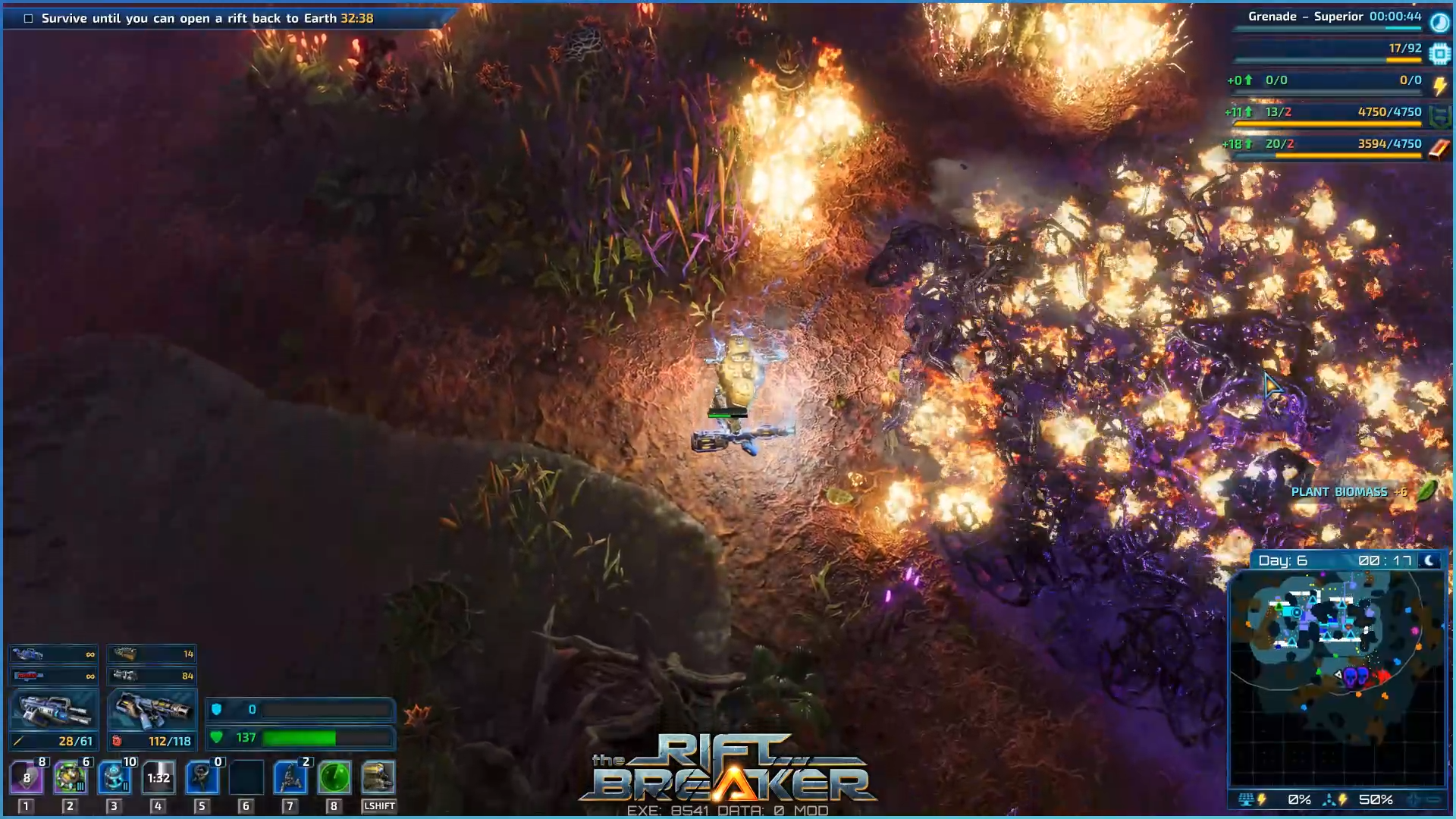
VERY IMPORTANT INFORMATION:
Our ongoing development of the Online Co-Op mode required us to rework our GUI model. For now, the Experimental Version of this update supports only mouse and keyboard controls. Your gamepad will not work with this version. Do not install it on your Steam Deck, either. We will add gamepad controls in one of the maintenance patches before the main release.

This update is (most likely) incompatible with any current mods. Please remove all mods before playing. MAKE SURE TO MAKE A BACKUP COPY OF YOUR SAVE FILES! Make a copy of 'The Riftbreaker' folder from your documents and keep it safe.
This Experimental Release is available to everyone on an opt-in basis. Please be aware that things might not work as intended and you may encounter problems. If you don’t want to take any risks, please wait for the public release of this update.
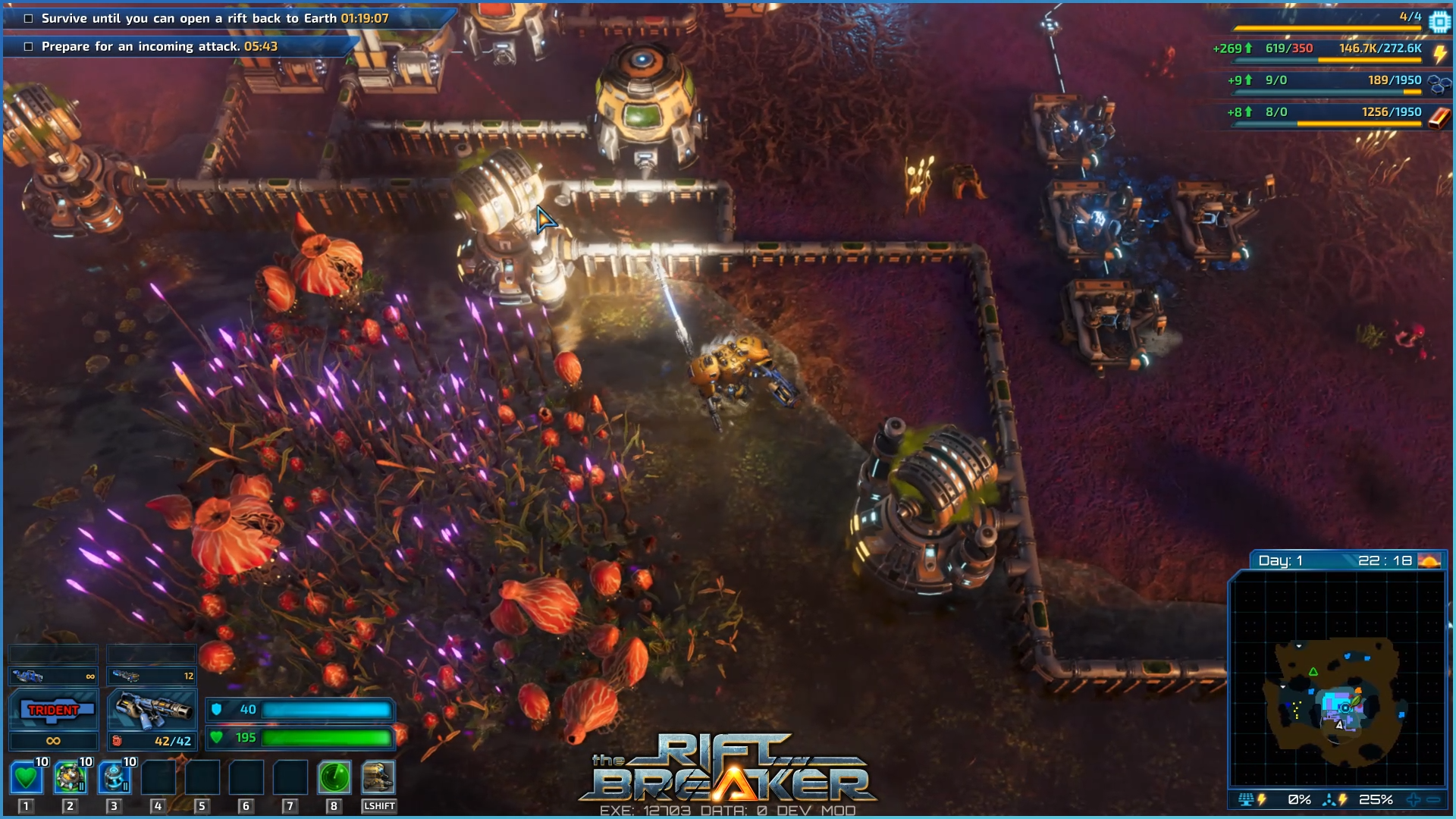
With all these warnings out of the way, here’s how to access the experimental branch:
- create a backup copy of your save folder (Documents/The Riftbreaker)
- disable Steam Cloud save backup for The Riftbreaker
- go to your Steam Library
- right-click on The Riftbreaker
- select 'Properties,’ then 'Betas,’ and use the following password: IknowWhatImDoing
After that, you will be able to choose 'experimental' from the drop-down menu. Download the update, play the game, and let us know if you encounter any issues. We also have a channel on our Discord: #rb-experimental-feedback - we highly encourage you to join in and share your feedback.
The changelog for this update is truly massive. Please treat it all as a potential spoiler.
The Riftbreaker World Expansion III Experimental Open Beta Test, May 24th, 2024. EXE: 683 DATA: 504 Changelog:
[expand type=spoiler]
FEATURES:
- New Creature: Invigor. It’s a carnivorous plant found in the Fungal Forest biome. It spends most of the time hidden beneath the ground, with only a small antenna sticking out as a lure. Invigor will spring up from the ground if prey gets close and bash it with a powerful melee attack.
- New Creature: Carnicynth. Another species of carnivorous plant of Galatea 37. Found in the Fungal Forest biome. Carnicynths disguise themselves as harmless bushes. However, if a suitable target comes close, Carnicynth will reveal its maw, which shoots venomous projectiles.
- New Creature: Artigian. A large carnivorous plant found in the Fungal Forest biome. This species does not employ any techniques to camouflage its presence. Instead of relying on stealth, it attacks its targets from a distance by hurling large, explosive projectiles formed within its massive pitcher-like maw.
- New Creature: Stickrid. A small insectoid creature. Prefers warm and humid environments. Its elongated, slender body is carried by three pairs of long legs. These legs allow Stickrids to keep their heads above the surface of shallow water pools. If threatened, Stickrid will keep its distance and try to attack the target with an acid projectile. Stickrids are also great climbers and utilize this skill to launch surprise attacks at unsuspecting prey.
- New Creature: Plutrodon. Like Stickrids, these creatures are great climbers and can be found on the ground and on tree branches. Plutrodons are very agile despite their bulky bodies being carried on only three legs. Plutrodons attack their targets from a distance. They cause razor-sharp spikes to come up from the ground. This makes them especially deadly against structures stacked next to one another, like walls and defensive towers, for example.
- New Creature: Fungor. It is a tall, menacing animal-mushroom hybrid moving around the Fungal Forest with six long tentacle legs. Due to their size, Fungors are quite slow, but they make up for that with their sheer physical strength. They hit like a truck and can make quick work of your defensive structures.
- New Creature: Mudroner. The Mudroner is a native species of the Galatean Swamp. These creatures can often be seen in small packs, roaming shallow waters. They bear quite a resemblance to Hedroners, which can be found in similar places around the surface of Galatea 37. They can attack their targets both from a distance and in melee range. When severely wounded, they will try to reposition themselves behind the aggressor.
- New Creature: Drexolian. Their bodies resemble a certain species of tree commonly found in forest areas around the planet. Their tall bodies are covered with hardened skin, resembling tree bark. It is quite stiff, which limits the creature’s mobility but gives it incredible resistance to many forms of damage. Drexolians are capable of fighting from a distance and in melee range. They are quite slow but can limit your mobility by raising temporary barriers straight from beneath the ground.
- New Creature: Canceroth. The Canceroth is one of the most unique lifeforms you will encounter while exploring the Swamp biome. At first, it looks like a colony of some sort. In the center of the colony, there is a large cell surrounded by several smaller ones, identical to the one in the middle. The colony moves as one, with the central cell controlling the entire group's behavior, rolling over the planet's surface with no regard for anything on its way. Canceroths leave a wake of destruction behind them, annihilating all organisms and structures they encapsulate.
- New Creature: Poogret. This large, neutral creature spends its days traveling across the Fungal Forest biome looking for the fruit of the Garlimonium plant. Poogrets are known to leave behind piles of waste filled with unrefined minerals. Digging through them is dirty work, but it will allow you to find bonus resources you can use later.
- New Creature: Parabian.
- New Creature: Darnot. A neutral flying creature. It resembles a very large moth. It flies around the Fungal Forest biome, pollinating the local flora and collecting nectar and small fruit from plants.
- New Alien Structure: Swamp Nest. It is used by multiple species of nesting creatures within the Fungal Forest biome as a home structure. What makes it dangerous is a giant acid-spitting maw located at the very top. It will actively seek out threats, aim at them, and bombard them with a barrage of acidic projectiles from a long distance. All these properties make it very likely that the nest is a living organism, forming a symbiotic relationship with the creatures of the Swamp biome.
- New Creature Variants: Gnerot Bosses now appear in previously missing versions: Acid, Energy, and Cryo. They all have damage resistances set to their corresponding elements and deal damage of different types.
- New Building: Floating Immolator Tower. This new variant of defensive tower uses liquid ammunition to shoot small fireblasts at the targets within its range. It can only be placed on liquid surfaces. However, the tower does not require any additional power source, making it a great choice for biomes where dry land is at a premium.
- New Building: Floating Piercer Tower. This enormous, 3x3 defensive tower is one of the most powerful weapons in The Riftbreaker arsenal. Like the Immolator Tower, it must be placed on water, but it doesn’t require anything but ammunition to operate. It shoots powerful, piercing projectiles that deal cryo damage and works over a very large distance.
- New Building: Power Rod Tower. Another massive, 3x3 defensive structure. It launches power rods straight into the air. The rods maneuver mid-air to land in the designated zone. When they do, they deal massive impact damage to everything in the vicinity. The power rod stays operational for a few seconds, dealing continuous energy damage to creatures in its range.
- New Building: Heavy Cluster Missile Launcher. The Launcher is the last large defensive structure in World Expansion III. It is a missile silo that shoots rockets filled with cluster bombs straight into the air, allowing the missile to avoid any terrain obstacles. The missile explodes mid-air, leaving cluster bombs free to carpet bomb a very large area.
- New Building: Shotgun Tower. It utilizes Large Caliber Tower Ammo to shoot volleys of projectiles at incoming targets. Its relatively short range is offset by the high firepower and fire rate.
- New Building: Gas Extractor. This building takes advantage of the naturally-occurring Flammable Gas Vents in the Fungal Forest Biome. When the Gas Extractor is placed on top of such a vent, it collects all the gas escaping from beneath the ground and transports it through pipes for further use.
- New Building: Bio-Condenser. This structure can be placed directly on the surface of muddied water pools. It will extract the organic matter from the water to create a concentrate, which is later mixed with water. The result is organic sludge that can be later processed into flammable gas.
- New Building: Pipe Junction. The number two most requested feature. Build this to allow two pipelines with different liquids to cross each other and not mix up.
- New Building: Vine Walls. These advanced walls cost a little bit more than the regular walls in The Riftbreaker arsenal but come with a range of benefits. First of all, when you come close to the wall, it will automatically lower itself beneath the ground, allowing you to shoot straight through it. Moreover, these walls have self-regenerating capabilities, meaning there is no need to repair them manually if not completely destroyed.
- New Building: Grass Floor. Unleash your inner gardener and turn your base into a garden with this perfectly-trimmed lawn.
- New Item: Gravity Modulator. It allows you to carry interactive objects from one place to another using your Mech’s arms. The use of this item is contextual - you don’t have to craft it or equip it. Simply use the ‘interact’ button when prompted to do so. You can give Garlimonium fruits to Poogrets this way, for example.
- New Item: Mortar Gun. It’s a variation of a Grenade Launcher that shoots explosive projectiles at an even higher arc, allowing you to overcome terrain obstacles more easily. The mortar projectiles deal energy damage.
- New Item: Repeater Rifle. This weapon uses Large Caliber Ammo. It is capable of very quick fire rates, limited only by your ability to pull the trigger. If you prefer a salvo instead of continuous fire, try the charged shot mode, which shoots a volley of bullets.
- New Item: Trident. It is a long-range melee weapon that attacks like a spear at first but then is separated into three damage-dealing spikes. It is effective against both individual creatures, thanks to its high fire rate and groups of creatures.
- New Item: Root Gun. It shoots a column of spikes that deal damage to all targets along the way. It’s as if the gun had infinite piercing! Perfect for reaching targets in the back of a group, while also dealing with the enemies up front.
- New Item: Flame Blade.It is a large, bladed melee weapon with a medium attack speed. Additioanlly, when you attack, a wave of flames bursts out in front of you, setting everything in front of you ablaze.
- New Item: Wasp Launcher. New research conducted in the Fungal Forest biome allowed Ashely to construct a weapon that works like a portable hive of angry, explosive bees. What’s not to love about this?
- New Item: Gas Grenade. It explodes into a cloud of toxic gas in a large area, dealing acid damage to enemies.
- New Item: Drone Swarm. This consumable item allows you to call in a couple of drones to aid you in battle. The drones will follow you around for a limited time and disappear when their batteries deplete.
- New Item: Charged Bomb. The technology known from the Portal Bomb Tower, now (literally) in your hands. Aim at the place you want to raze to the ground, charge your weapon, and release the trigger. An armed explosive will be teleported to the chosen location. Very useful at sniping high-priority targets.
- New Item: Fertilizer. This is a consumable item that you can use to make the flora around Mr. Riggs to regrow at a staggering rate for a limited time. Never run out of plant biomass again!
- New Item: Mortar Sentry. This consumable sentry turret lobs explosive projectiles at the enemies in range for as long as the battery allows it to operate.
- New Feature: Power Wells. These mysterious objects will grant Mr. Riggs powerful ability boosts when activated. They last only for a short time, but can completely turn the tide of battle in your favor.
- New Feature: More Lootables on the Map. When you start a new Campaign Mode run or a Survival run, you will find a lot of small objects similar to Bioanomalies scattered across the map. It might be worth checking them out - you never know where you can find resources.
- New Feature: Dynamic World Size. The map area can now expand as your missions progress. You may experience this in certain moments of the World Expansion III additional Story Campaign branch. However, modders may use this feature as well when creating their custom maps and missions.
- New Resource: Resin. It can be obtained by attaching a pipe to one of the resin trees growing around the Fungal Forest biome. Resin can be used as a substitute for plasma. It will allow you to take advantage of shield generators and fusion power plants more easily. Heavy Artillery, anyone?
- New Weather Event: Firestorm. This causes the wind to pick up significantly. Spontaneous fires start consuming flammable objects around the map and spread uncontrollably. Unfortunate, if you wanted to harvest plant biomass, but great if you relied on wind turbines.
- New Weather Event: Fireflies. Thousands of little, bioluminescent insects spark up in the night, flying around for you to marvel at.
- New Weather Event: Blooming Air. The air becomes thick with spores released by various plants and mushrooms around the swamp. It reduces solar and wind power production but makes all plants around the biome regrow much more quickly.
- New Weather Event: Monsoon. A massive rainfall, accompanied by very strong wind. It only encompasses a limited portion of the map, instead of the entire region. Your Solar Panels might still work if they are located far from the eye of the storm!
- New Weather Events: Fire and Acid Tornadoes. Even more devastating than regular tornadoes you have been experiencing on Galatea 37 up to this point. On the bright side - they look quite cool.
- New Skins for Mr. Riggs. In this Expansion we bring you a couple of our own designs, as well as skins submitted to the Skin Design Contest a couple of months ago.
- New Feature: Prop Sets. This is a feature that we recently incorporated into our Editor Suite that allows us to achieve greater variability when creating maps. In short: we create a base set of props, populate the maps using that set, then select alternative props the game can use to replace them. You can read more about this feature here.
- New Soundtrack. Enjoy almost 30 minutes of original soundscapes composed by Marcin Pukaluk. The new tunes accompanying the biome feature ethnic instrumentations and wild rhythms you won’t hear anywhere else on Galatea 37.
- Two New Survival Mode missions. Try your skills in the classic, land-based Fungal Forest map, or take on a new challenge in the Fungal Swamp, where dry land is a luxury. Build your base on several islands, solve logistic problems, and make use of new tech in this unique setting.
- Non-raytraced shadow mapping has been refactored to enable multiple shadow-casting lights without raytracing. Thanks to this improvement, we were able to add shadow casting capabilities to additional scene elements like Power Wells, player skills, high-powered projectiles and more. The overal quality and performance of traditional non-raytraced shadow mapping has been significantly improved. The maximum number of shadow casting lights is currently determined by the Shadow Quality setting.
- Creature damage resistance behavior has been changed. The maximum damage resistance for a creature of any type is now 90%. This means that creatures like Gnerots will now suffer a minuscule amount of physical damage when attacked with a small machine gun, for example. However, you will still see the ‘RESISTED’ message appear to let you know that what you’re doing is not very effective.
- We changed the appearance and behavior of danger markers, which appear when you’re targeted by the enemy artillery or other dangerous, time-delayed attacks. The markers are now much more visible and give you a proper chance to defend yourself.
- The Automated Resource Gathering buildings have had their building speeds and costs changed, since the previous values have been too low. The drones have been buffed to match the new cost.
- Lightning Towers now have a significant energy upkeep cost, replacing the previous placeholder value. This change has been made to make them more in line with other energy-based towers.
- The Swarm Missile Launcher has been exhumed from the grave we put it in the last time. The missiles are much stronger, and the shooting pattern has been changed to increase the overall DPS. Firing accuracy also depends on firing time i.e. the first missile flies almost straight and the more you shoot the aiming spread becomes wider.
- Minigun fire rate has been reduced to make its firepower more in line with the other weapons, especially at the extreme quality level.
- Orbital Laser and Orbital Bombardment now have a slight delay between activating the skill and the beginning of the actual attack. Attack delay markers are also visible on the ground before the attack begins. For Liberty.
- The maximum amount of damage reflection for boss creatures has been reduced from 20% to 10%, so that they don’t die to their own attacks so easily.
- Flashing effect during thunderstorm has been reduced.
- Reworked Shegret attacks. Now you will actually be able to see a Shegret Alpha and a Shegret Ultra in the game! The attacks have three difficulty levels that are chosen dynamically depending on the moment of the game you’re in.
- Similarly, we’ve added three tiers of Kermon and Phirian surprise attacks that might happen in between regular attack waves.
- The weapons display in the inventory has been reworked. The weapon stats now always appear in the same spot on the list. The list itself should be a lot more legible now.
- Added grouping to weapon mods. Mods from the same category will now be grouped on the list of available mods, which will save you from scrolling a hundred miles.
- Changed the weapon mod design: “X Stat Enabled” mods no longer exist. This means that if you want to add piercing to a weapon that didn’t have this stat before, you no longer need to install a “Piercing enabled” mod, and then another piercing mod on top of that. Just one mod will do the job. This way you can create more fun and powerful combinations of mods.
- Main Menu has been reworked to accommodate more options. Let us know how you like the sleek modern design!
- Liquid Rendering overhaul. Thanks to Tiled Deferred Rendering upgrade, we finally have the support for transparent materials in The Schmetterling Engine. It allowed us to develop a completely new liquid simulation, with transparency, waves, light shafts and all sorts of cool things! We’ve written an article about it and you can check it out here.
- Mudroner material upgrade. Mudroners and Hedroners of all strains have received a visual upgrade - the liquid they are covered with now flows down their backs like in real life.
- GUI refactoring and upgrade. Over the years, we have added layers upon layers of new code into our GUI system, making it almost impossible to work with. We decided to rewrite the entire thing from scratch to despaghettify (this is professional terminology) our GUI and allow us to introduce some changes and updates. This rework will allow us to add new screens more easily and make the current ones more functional. Since we reworked all buttons, sliders, pop-up windows, graphs, and text boxes, we need some feedback. If you find any errors, let us know. Fixing things will be much easier with our new, clean code-base.
- We’ve introduced major performance optimizations. Initially, we did that to improve the multiplayer experience. However, it turned out that the optimizations we found also benefit the performance when running the game solo. You should see an improvement in performance in most scenarios with this update. For more details, read this article.
- Online multiplayer framework changes. We have introduced thousands of code changes, making multiplayer more stable, more playable, and much closer to where we want it to be. We hope to share the results with you soon, but know that the majority of the game’s code base is now adapted to support online play.
- Updated creature and item placement for all survival mode missions. Adding the new, smaller Bioanomalies and Power Wells required us to change the placement of in-game curios a little bit. We made sure that you will find something interesting on each of the map tiles, but beware - there are some dangerous creatures guarding these secrets!
- New biome tiles. We have added more diverse map tiles to all the biomes from the original release of the game - Jungle, Acid, Desert and Magma. The number of tiles is now on par with those for the World Expansion biomes. This will result in more variability in map generation.
- Changed plasma chain bulding costs in survival mode. Fusion power and Shield Generators were not a feasible strategy with their old cost. The new costs should make them a more viable option. Additionally, Fusion Power is unlocked by default in the Fungal Swamp biome.
- Various creatures have been given the ability to traverse mud and other liquids. Apart from the native creatures of the biome, you will also encounter Baxmoths, Phirians, Kermons, and Nurglaxes in the Fungal Swamp. This ability will allow them to actually reach your base and be a feasible threat.
- Baxmoth balancing changes. The drone’s projectile speed and splash damage have been reduced. This makes them significantly easier to dodge. However, Alpha and Ultra strains now have improved drones that deal more damage. This way, the creature is still deadly for stationary targets, but not unavoidable by the player.
- More environmental sounds. We have added ambient sounds playing in the background in various spots on our map tiles. These are subtle sounds - for example, water dripping from the cave walls, crickets chirping, or birds singing. The world will feel more alive thanks to this.
- Introduced changes to the research tree - it uses the old, three-tab layout, but it can now be scrolled and zoomed.
- Reduced fusion powerplant and nuclear powerplant costs in the survival mode in an attempt to make them more easily accessible.
- Fixed shockwave explosion splash damage falloff.
- Fixed memory leaks caused by some particle effects.
- Fixed artillery projectile properties.
- Fixed many issues with streaming events not working properly.
- Fixed Ionizer text description.
- Gravity Grenades no longer deal damage to friendly targets.
- Fixed problems with fog on DirectX 11.
- Fixed memory leaks in TimeDamageSystem.
- Fixed memory leaks in DecalSystem.
- Fixed issues with Mr. Riggs movement on slopes.
- Fixed the math formula for DPS calculations.
- Fixed problems with Caverns Sonic Grenades mission.
- Fixed problems with the ‘Find Tanzanite’ mission - for real this time.
- Fixed problems with skinning on Crystal Gun and Heavy Plasma Gun.
- Fixed the Wingmite spawn problem in the last Survival Attack wave. The game spawns 50 Wingmites 2 times now, not 2 Wingmites 50 times.
- Fixed light ranges in Bioanomalies.
- Fixed problems with recharging traps using the repair tool.
- Fixed brutal difficulty save settings for the Caverns campaign outpost.
- Fixed wave announcements and difficulty levels for units spawned from Nests.
- Fixed crash on resuming sound source that already finished playback.
- Fixed objective progress problems in Campaign Mode.
- Fixed a crash in the Sound System on game shutdown.
- Fixed shadow position mismatch between shadow mapping and lighting.
- Fixed Necrodon behavior when running away from danger.
- Fixed the ‘Take away all ammo’ stream event.
- Fixed the Ion Storm bug that allowed players to get rid of map interference by opening and closing the map.
- Fixed entering build mode during the boss fight in DLC2.
- Fixed wrong level icons in Acid Spitters.
- Fixed upgrade tool calculating cost taking building during an upgrade.
- Fixed vegetation lifecycle getting blocked after a plant is burned down.
- Fixed a crash on load in TerrainAffectorSystem.
- Fixed the cost of Plasma Converter Level 3 (it used to be the same as level 2).
- Fixed emissive textures not working on gun barrels.
- Fixed description order in the building info window - all stats now appear in the same order in all cases.
- Fixed ‘Acid Find New Resource’ mission main objective timer.
- Fixed Damage Over Time effect memory leak.
- Fixed minimap zone display error in Metallic Valley ‘Investigate the Crater’ mission.
- Fixed memory leaks caused by decals.
- Fixed decal alpha blending.
- Fixed a crash in the Sandbox Menu Panel when spawning Magmoths.
- Fixed the Caverns entrance objective marker positions across multiple missions.
- Fixed missing progression dialogue in Caverns Exploration mission.
- Fixed shadow sharpness in some cases.
- Fixed multiple building collision sizes to prevent mech clipping.
- Fixed cooldown categories in multiple consumable items.
- Fixed a problem with Arachnoid Sentinels not firing their projectiles.
- Fixed a problem with melee units not attacking buildings effectively.
- Fixed Loot Drones ignoring mods on the ground.
- Fixed an issue with lamps not turning on after loading the game.
- Fixed a crash when trying to launch the game in safe mode.
- Fixed weapons aiming angle after dropping a weapons when the player is killed.
- Numerous fixes and optimizations to the pipes system. Compressors and Decompressors should work properly now.
- Fixed a bug that caused the minimap interference to disappear after opening the large map during the ion storm event.
- Fixed status icons missing from buildings.
- Fixed a problem that caused light affectors to behave in an unintended way after walking off the screen.
- Research Screen: fixed 'Build a Comm Hub' message visibility.
- Build menu: fixed upgrades 'prev page' and 'next page' buttons visibility after use.
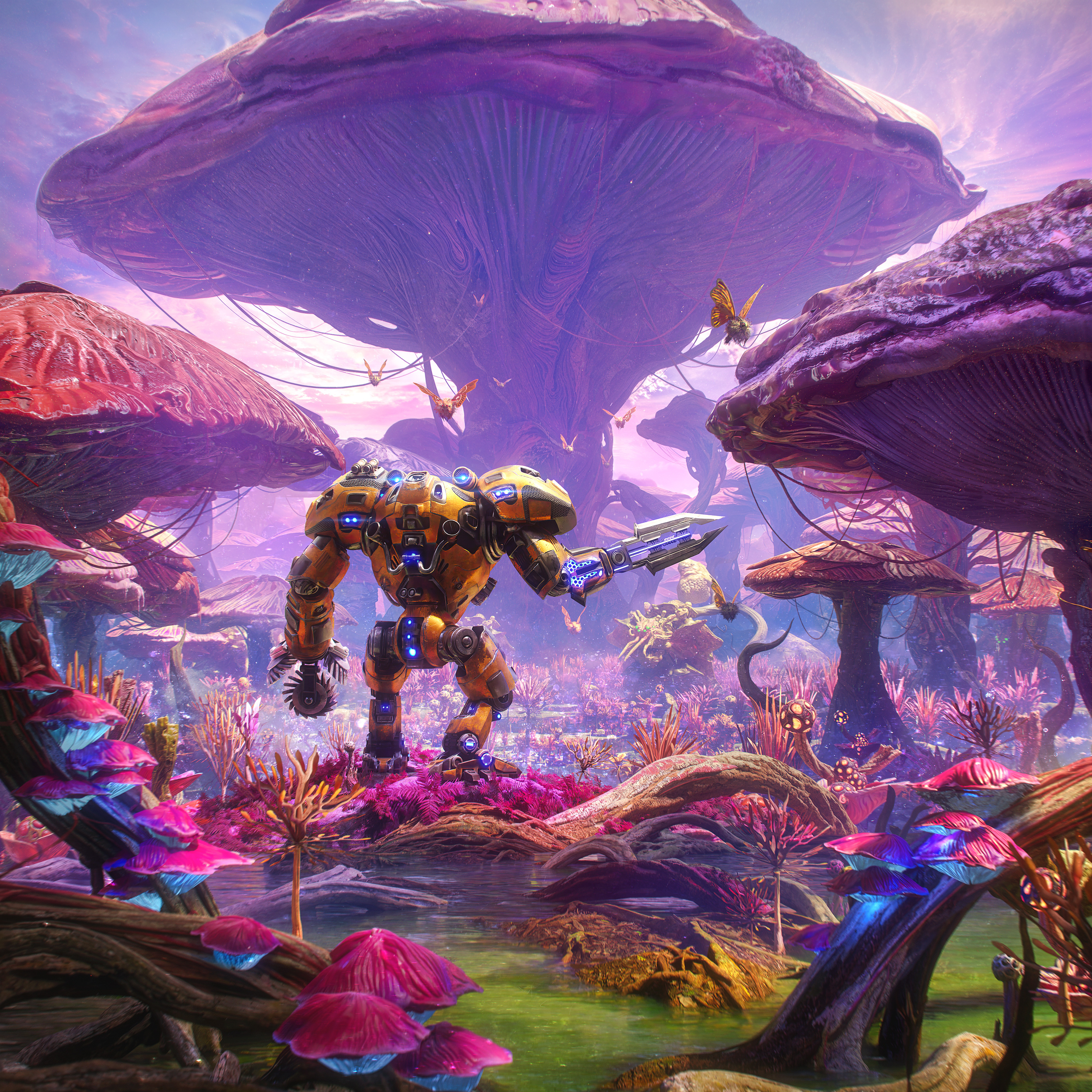
We're looking forward to hearing what you think about the update!
EXOR Studios






